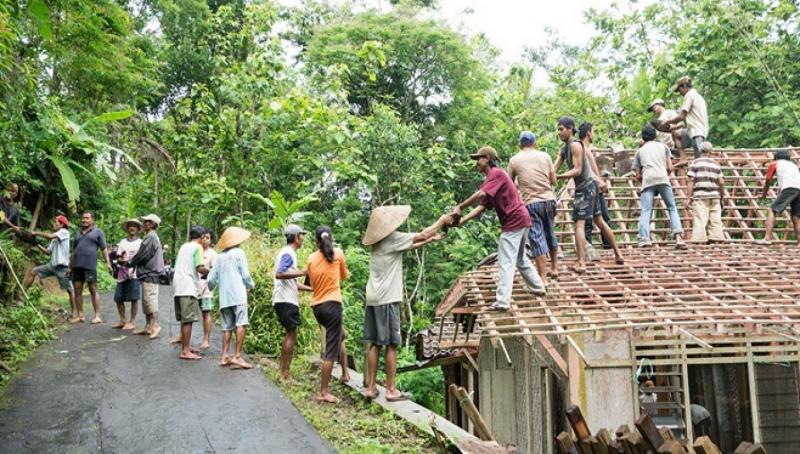Imagine a village where neighbours don't just live side by side. They build together, celebrate together, and recover together. In Southeast Asia, this isn't just an idealistic vision; it's everyday life.
From Indonesia's gotong royong to the Philippines' bayanihan, the region thrives on a deep-rooted culture of mutual help that turns strangers into family and individual struggles into shared triumphs.
In a world where loneliness is a growing epidemic, and individualism often leaves people feeling disconnected, Southeast Asia's collective spirit offers a refreshing antidote.
This isn't just about being nice. It's a survival strategy, a social glue, and a philosophy that has shaped communities for centuries. So, what exactly makes this value so powerful? And why should the rest of the world take notes?
The Heart of Southeast Asia: It's All About "We"
Walk into any Southeast Asian community, and you'll quickly notice something: people don't just look out for themselves. Whether helping a neighbour rebuild their home, sharing harvests, or pooling resources during a crisis, the idea that "your problem is my problem" runs deep.
This collectivist mindset isn't accidental. Historically, life in Southeast Asia, with its lush rice fields, unpredictable monsoons, and tight-knit villages, required cooperation. You couldn't farm alone, rebuild after a storm alone, or celebrate a wedding alone. Survival meant teamwork.
But this goes beyond practicality. It's woven into the region's social DNA:
- Harmony over conflict – Many Southeast Asian cultures prioritise "saving face," avoiding public confrontation to maintain social peace. This isn't about hiding emotions. It's about preserving relationships.
- Elders as anchors – Respecting elders reinforces community stability, ensuring knowledge and traditions are passed down.
- Radical hospitality – Ever been to a Filipino home? You'll leave stuffed with food, even if the host barely knows you.
These values create a culture where mutual help isn't just encouraged. It's expected.
Gotong Royong, Bayanihan & More: How Mutual Help Works in Action
While the spirit is universal, each Southeast Asian country has its flavour of collective action:
Indonesia: Gotong Royong ("Lifting Together")

Picture a village where everyone young and old picks up brooms to clean the streets, or farmers take turns working each other's fields. That’s gotong royong in action. Even Indonesia's first president, Sukarno, called it the nation's founding principle.
Real-life example: After the 2004 tsunami, communities in Aceh rebuilt homes together—not waiting for outside aid.
Philippines: Bayanihan ("Being a Community")

The iconic image of villagers carrying a bamboo house on their shoulders symbolises bayanihan, who believes that no task is too big when many hands pitch in.
Real-life example: During Typhoon Haiyan, strangers shared food, shelter, and boats to rescue survivors before official help arrived.
Thailand: Lo Kang (Rural Mutual Aid)
In Thai villages, neighbours help with farming, house-building, and funeral preparations. It's not transactional; it's reciprocal.
Vietnam: Đổi Công ("Labour Exchange")

Farmers swap workdays during planting and harvest seasons, ensuring no family is left struggling alone.
Laos, Myanmar, Brunei & Beyond
The same principle applies from Laos' o khèng ngān (community cleaning days) to Brunei's strong family support networks: We're stronger together.
Why This Matters Beyond Southeast Asia
In an era of hyper-individualism, many societies grapple with loneliness, distrust, and crumbling community ties. Meanwhile, Southeast Asia's model offers solutions:
1. Fighting Loneliness with Belonging
Studies show that social connections, such as diet and exercise, are vital to health. Mutual help builds instant support networks and fosters a deep sense of belonging, something Western societies, where 1 in 3 people report feeling lonely, desperately need.
2. Disaster-Proof Communities
When crises hit, mutual aid groups often respond faster than bureaucracies, providing a sense of reassurance and security. (Just look at how bayanihan kicked in during Philippine typhoons.)
3. A Cure for "Not My Problem" Syndrome
Individualism has its perks, but it can also lead to bystander apathy. In Southeast Asia, helping isn't optional—it's a deeply ingrained cultural duty, inspiring and motivating individuals to lend a hand.
4. Sustainable Living
Shared labour means less waste. Gotong royong repairs instead of replaces; bayanihan shares instead of hoards.
How the World Can Adapt This Spirit
You don't need to carry houses on your shoulders to embrace this mindset. Small shifts can make a difference:
- Start hyper-local – Organise street potlucks or skill-sharing swaps.
- Normalise asking for (and offering) help – In the West, independence is prized—but interdependence is healthier.
- Tech-enabled mutual aid – Apps like Nextdoor or community Facebook groups can modernise the village spirit.
- Policy support – Governments could incentivise community projects (e.g., tax breaks for volunteer groups).
Final Thought
Southeast Asia's mutual help traditions prove that progress doesn't have to come at the cost of community. In a divided world, this ancient wisdom feels strikingly modern, a reminder that the best way forward isn't me first but all of us together.
So next time you see a neighbour struggling, ask, "How can we fix this?" That’s the spirit of gotong royong. Honestly, the world could use more of it.


















